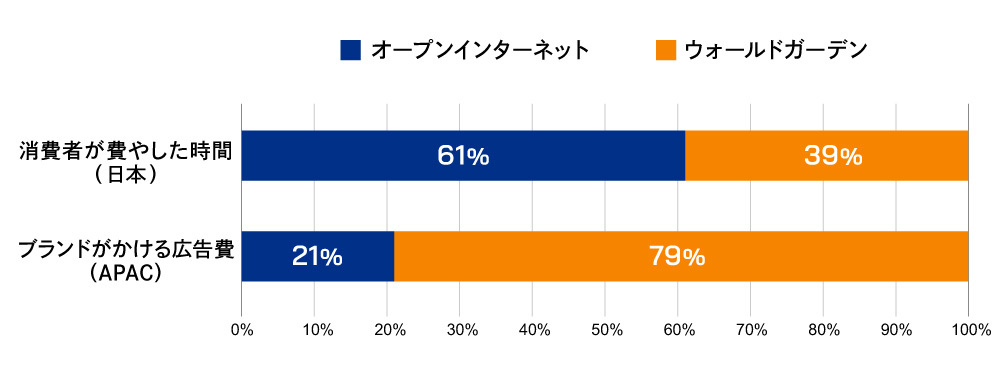
From left: Takashi Sone, The Trade Desk Japan; Shu Endo, Dentsu Digital Inc.; Joonse Lee, GumGum Japan; Hirotsugu Doi, GumGum Japan
This series explores the latest trends in digital advertising for the 'cookieless era' through the initiatives of GumGum Japan, a leader in contextual targeting advertising, and various companies within the Dentsu Group.
For example, contextual targeting ads are delivered to media and content deeply related to a brand—such as displaying an automotive brand's ad alongside automotive-related articles.
Contextual targeting involves displaying ads highly relevant to the article for users who have come to view it out of interest.
This time, we present a branding ad case study for Volkswagen, a collaborative effort between three global DSP leaders: The Trade Desk, GumGum Japan, and Dentsu Digital Inc.
The Trade Desk enables cross-media and cross-device ad delivery with detailed attribution analysis.
GumGum Japan provides cutting-edge digital advertising technologies such as "contextual advertising," "rich ads," and "attention time."
What does the "present" of digital advertising look like, as revealed through our collaboration with both companies!?
The "unseen indirect effects" missing from traditional branding ad measurement

Mr. Endo, Dentsu Digital Inc.
──First, please introduce yourselves and describe your roles in this project.
Endo: I'm Endo, a planner at Dentsu Digital Global Center. I provide end-to-end support for domestic and international clients' marketing operations, primarily focusing on strategy development, planning, and execution within the digital domain.
Sone: I'm Sone, a Trading Director at The Trade Desk (TTD), headquartered in the United States.
TTD is a company specializing in providing DSPs (※1) that support advertisers with digital ad delivery. Its key feature is enabling advertisers to achieve the most beneficial media buying by analyzing data impartially from a neutral third-party position, free from ties to specific media or SSPs (※2). It also supports omnichannel strategies, allowing cross-platform analysis of delivery results across numerous SSPs, including GumGum, and detailed advertising effectiveness.
※1 DSP (Demand-Side Platform)= A system supporting advertising purchases on the demand side, i.e., the advertiser side. It connects with SSPs (Supply-Side Platforms), which support the media side, to manage multiple media outlets collectively. It assists with bidding, delivery, and analysis to meet advertiser specifications.
※2 SSP (Supply-Side Platform) =A system supporting the monetization of the supply side, i.e., the "media side." It helps media outlets providing ad space on the internet efficiently sell and utilize their ad space to maximize revenue.
Junsu: I'm Junsu, responsible for ad operations at GumGum Japan (hereafter GumGum), which provides a contextual advertising ad platform. For this Volkswagen project, I'm working as the SSP, collaborating with Dentsu Digital Inc. and TTD to optimize ad operations.
Doi: I'm Doi, also at GumGum, serving as Sales Director. I handle projects broadly across the Dentsu Group, including Dentsu Digital Inc. In addition to being the point of contact for GumGum's various media partners, I coordinated with TTD and Dentsu Digital Inc. for this Volkswagen project.
──Could you outline the Volkswagen initiative?
Endo: For this project, we delivered advertising with the primary goal of branding the Volkswagen "ID.4." The "ID.4" is the company's first EV (electric vehicle) launched in Japan.
Specifically, we delivered video ads targeting users centered around our main target audience: those considering purchasing an EV. To deliver the ID.4 brand message across various touchpoints, we ran a cross-media, cross-device campaign utilizing TTD. As one of the media channels, we leveraged GumGum's contextual advertising.
For the delivery, TTD's "attribution analysis function" was used to analyze the "path" to conversion (CV) points on the web. This means analyzing not only the "ad click that ultimately led to conversion," but also where and which ads the user encountered before clicking that final ad. This path is called the conversion path (CV path).
──What exactly is TTD's attribution analysis, and what challenges does it help solve?
Sone: Many users browse multiple ads via SSPs while researching topics of interest or enjoying various content online before converting. Attribution analysis dissects this "process leading to conversion" (※3).
※3 Attribution analysis = A method that visualizes not only the final ad clicked/tapped leading to conversion but also the user's actions, such as ad exposure, leading up to that point, measuring the indirect contribution to conversion.

Users convert through various media and SSPs. This time, "visiting the dealer search page" was set as the conversion. When analyzing all conversion paths as flowcharts, GumGum's contextual ads contributed nearly twice as much to conversions compared to other media and SSPs. The diagram above simplifies the overall picture; in reality, many more paths exist.
Endo: As a result, we found GumGum's conversion contribution was higher than other SSPs. This led us to optimize our budget allocation towards GumGum, which demonstrated high conversion contribution. The core of this initiative was to effectively drive user attitude change by creating "valuable impressions."
──How did Dentsu Digital Inc. perceive the challenges advertisers faced with digital advertising in their top-funnel initiatives?
Endo: Traditional digital advertising tended to focus on a "harvesting" approach, primarily targeting conversion (CV) and cost per acquisition (CPA) performance at the bottom of the marketing funnel. However, in recent years, the importance of "increasing brand awareness" at the top of the funnel has grown significantly within digital advertising. Correspondingly, more platforms with strengths in video advertising and rich creative formats have emerged.
However, when evaluating top-funnel branding efforts using traditional metrics like reach, impressions, CPM, or view-through rate (VTR), there are inherent limitations in assessing and delving into the "true advertising effectiveness." While advertisers generally understand the importance of brand awareness initiatives, the difficulty in clearly demonstrating ROI and business contribution often makes budget allocation challenging.
The major achievement of this project was visualizing the "unseen business contribution of branding" through TTD's advanced analytical capabilities.
──Please tell us about Dentsu Digital Inc.'s role within the project.
Endo: Our primary role was to establish an operational framework enabling optimal ad delivery for the advertiser. We held weekly meetings with TTD from the project's start, checking ad campaign conditions and making detailed adjustments.
We also engage in direct dialogue with SSPs, including GumGum, monitoring their performance, providing feedback, and driving improvements. Additionally, we maintain an operational framework that constantly captures various information, such as solution updates from each company, and translates it into real-time strategies.
Sone: Dentsu Group companies not only have highly literate members, but I'm also very impressed by their strong commitment to thorough analysis and translating it into "concrete actions." Mastering the vast and diverse data we provide for ad delivery isn't something just anyone can do.
I believe this is part of their culture. Specifically, I sense a pioneering spirit among the members of Dentsu Digital Inc., actively incorporating overseas case studies that no one in Japan has attempted yet.
Endo: Since both TTD and GumGum, our partners this time, are U.S.-based companies, we also have strong collaboration with Dentsu Inc. Global, centered around Dentsu Inc. US. We've received cooperation from both companies as we bring advanced overseas cases to Japan.
D oi: While SSPs like GumGum receive orders from Dentsu Digital Inc., they build a flat relationship with us from the perspective of being partners working together to achieve the advertiser's goals. This makes it very easy to work with them.
Measuring video ad contribution to conversions from multi-media "conversion paths"

The Trade Desk Japan, Mr. Sone
──Please tell us what benefits attribution analysis offers advertisers.
Sone: TTD exclusively provides DSP services, maintaining an unbiased position. This allows us to analyze cross-media/SSP delivery in a flat manner. The acquired data is linked to a wealth of attributes—such as when and where users interacted with which creative on which device/media—all while prioritizing privacy.
Because we can provide advertisers with extremely rich data without favoring specific media, we can generate outputs and insights like this conversion path analysis. I believe this is TTD's strength compared to other companies.
Endo: Based on all impressions, it visualizes which specific media were touched that indirectly led to conversions, including the actual media names. I find it innovative that it allows evaluating conversion paths while ensuring transparency and fairness.
Sone: For this project, we delivered ads across various media and SSPs. Our integrated analysis revealed that GumGum ads contributed significantly to indirect conversions.

GumGum's share of all impressions was 22%. However, its share for the conversion "Completed test drive inquiry search" was 52%, and its share for the conversion "Visit to dealer search page" was 64%. These conversion shares are 2.4 times and 2.9 times higher than its impression share, respectively.
Endo: Comparing GumGum's campaign to other media and SSPs, we found that the conversion rate for "inquiry completion" relative to impressions is 2.4 times higher. Furthermore, the conversion rate for "users visiting dealer search pages" reaches 2.9 times. As such, since the share of conversions relative to impressions is more than double that of other media, GumGum is considered to have a high conversion contribution.
What is "Attention Time," which correlates with brand lift?

Mr. Doi, GumGum Japan
──Why was GumGum able to achieve ad delivery with such high CV contribution?
Doi: GumGum features the following three solutions.
- Contextual targeting that captures target users' moments
- High-quality "Rich Creative" optimized for contextual advertising
- "Attention Time," which quantifies users' focus on ads
Combining these elements gives us a significant advantage in driving user attitude change.
While other vendors offer contextual advertising and attention time, we believe GumGum holds a competitive edge in both technology and creative execution.
For example, many vendors handle contextual advertising by first converting Japanese to English for context analysis, which reduces accuracy. Our technology correctly understands Japanese as Japanese, enabling us to deliver ads on content that matches more "contextually."
Furthermore, we can target ads after comprehensively analyzing not just text information, but also information including images, audio, and video.
※Contextual advertising = Programmatic advertising that leverages context analysis to place ads on media/content matching the brand, reaching consumers well-suited to that brand.
"GumGum Creative Gallery"
https://japan-gallery.gumgum.com/
※Supports switching between PC browser view, smartphone view (portrait/landscape), and tablet view (portrait/landscape)
Regarding rich creatives, we pursue appropriate creative expressions as contextual advertising—not merely combining static images and videos, but capturing the message clients wish to convey and the product's features.
Volkswagen's EV video ad was delivered to news site ad spaces through "contextual analysis." Beyond ensuring no mismatch between the ad and article content, the visual design features a cable plugging into the car to visually convey its EV nature.
Finally, by measuring the number of seconds a user actually watches the ad—known as "attention time" —we can quantify the level of genuine interest shown.
This time too, I believe combining these three elements to drive user behavior change ultimately led to a high conversion contribution.
Junsu: Among these, GumGum's ability to optimize ad delivery "in real time" during ad serving by leveraging attention time is a major strength. Traditionally, ad impressions were counted as "1 impression" regardless of whether the ad was merely displayed or actually viewed attentively. By incorporating Attention Time—which measures whether users are focusing on the ad—into analysis, we can achieve more precise effectiveness measurement.
──What are some examples of how this can be used?
Junsu: Video ads already had metrics like "CPCV" (cost per complete view) and "VCR" (video completion rate). Adding the attention time metric allows visualization down to details like, "CPCV and VCR are high, but actually, the attention time wasn't long."
Furthermore, we're discovering a strong correlation between attention time metrics and brand lift. By excluding "ads with low attention time" during the PDCA cycle, we can enhance advertising campaign performance.
Pursuing a more fundamental approach to advertising suited for the cookie-less era

Junsu, GumGum Japan
──These three companies are challenging the cutting-edge trends in the rapidly changing world of digital advertising. Please share your challenges regarding the current state of digital advertising and your outlook for the future.
Junsu: When speaking with domestic advertisers, I often find many haven't clearly visualized specific countermeasures for the cookie-less era. We want to communicate more widely that our contextual advertising is an effective option. I believe contextual advertising enables more "fundamental" targeting than merely serving as a "replacement" for third-party cookies.
Attention time is also a metric previously absent from the market, so understanding is still developing. However, it's another metric that can evaluate "fundamental advertising effectiveness." Our immediate mission is to spread awareness of its high correlation with brand lift, among other things.
Endo: At Dentsu Digital Inc., we want to widely communicate to Japanese advertisers that "the era where we can scientifically measure the results of branding ads has already arrived."
With the arrival of the "cookieless era," pursuing metrics like CPC and CPA through traditional targeting ads is reaching its limits.
Rather than optimizing based on limited data and fragmented advertising metrics, the importance of operations using "fundamental metrics" like attention time is growing ever greater. For example, determining which media most effectively captures the target user's "attention" will become a major factor in advertising operations.
To deliver ads that provide value for both advertisers and users, we want to actively leverage these latest technologies.
Sone: Among the current challenges in Japan's digital advertising landscape is the imbalance in investment across platforms. Despite users spending over 60% of their available time on the "open web," advertising budgets tend to concentrate on the "walled gardens" of major platform operators (※4).
※4 Open web, walled garden = Platforms where a single operator runs the service and exclusively manages user data, such as specific social media or search sites, are called "walled gardens." In contrast, the ecosystem spanning multiple operators, including independent news sites, blogs, and forums, is referred to as the open web.

Users spend more time on the open internet, yet advertising spending tends to concentrate in walled gardens. While the advertising data is from APAC, the trend in Japan is largely the same. Image
from The Trade Desk website Walled gardens, which marketers themselves are likely familiar with as users, are accessible. However, advertisers and media must follow the rules set by the platforms.
However, we believe that in media buying, platforms should remain tools, with advertisers and media outlets retaining control. The current situation risks undervaluing media and reducing the distribution of quality content.
In contrast, TTD enables analysis and distribution without being constrained by platforms. Within an open web ecosystem centered on users, it delivers cross-platform, flat data to advertisers while protecting user privacy. And ideally, the optimal decisions based on that data should be left to the advertisers themselves.
Endo: In Japan, the majority of internet advertising spend is invested in walled gardens, whereas overseas, more investment flows into the open web. This clearly shows Japan has yet to fully unlock the potential of the open web. This project serves as a case study demonstrating the open web's possibilities.
Sone: I agree. While some worry about ad quality and ad fraud on the open web, using DSPs and SSPs allows us to control delivery in a user-friendly way. We can eliminate fraud, set appropriate frequency caps across media to prevent excessive exposure, and more. I believe we need to further spread awareness of this approach going forward.
Doi: For branding, "how it changes the user's mindset" is crucial. In that sense, for video ads as top-funnel initiatives, metrics like CPC or CPV aren't always the optimal solution. Instead, it's more important to utilize contextual targeting to deliver "the right ad at the right moment for the user" and to plan with attention as a key metric.
Earlier we discussed ad fraud. Forcibly inflating impression counts diverges from advertising's fundamental purpose. If ads become intrusive or damage brand reputation, it defeats the entire purpose. GumGum aims to contribute to building a healthier online advertising environment by collaborating with TTD and Dentsu Inc.
Endo: Yes, I agree. With cookie-less advertising becoming mainstream in 2024, I believe we're facing a moment to redefine the essence of advertising. We also want to clearly communicate new technological innovations that capture the spirit of the times, such as attention and contextual advertising, to our advertisers and lead our clients' digital marketing efforts. Thank you for today!



















